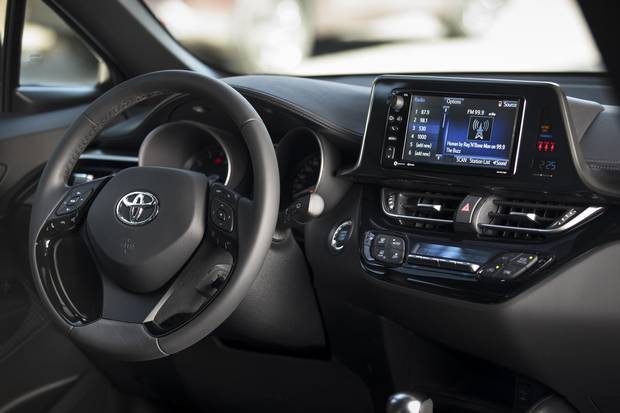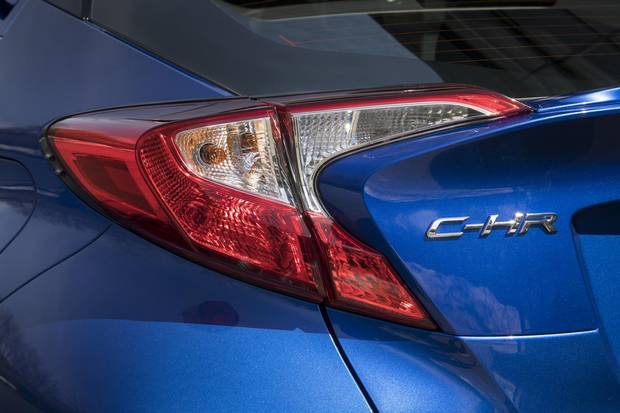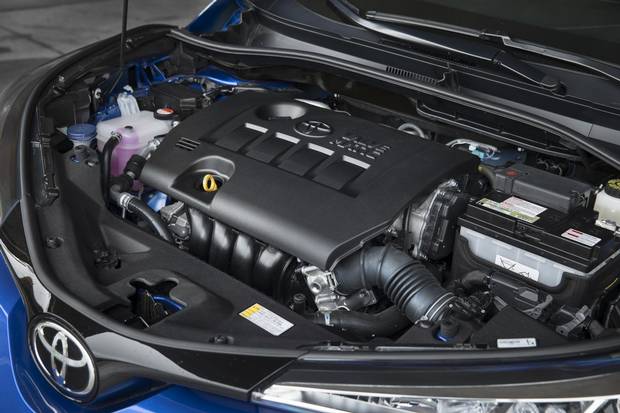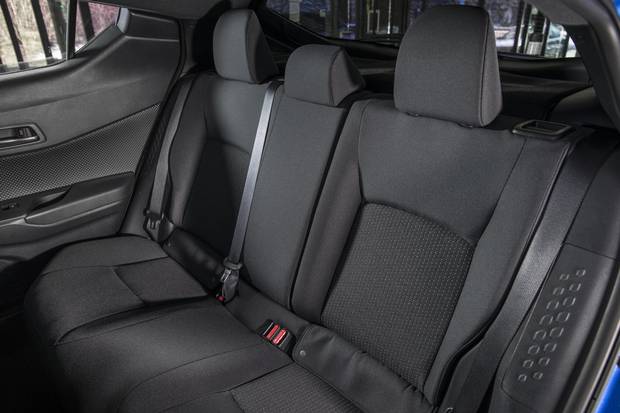It doesn't rain much harder and heavier than it did on the day Toyota introduced its new C-HR small crossover to Canadian roads. Water slammed into the asphalt and poured in rivers across the highway. Ditches filled to the brim. Wipers stayed on double-speed.
I peered into the grey ahead and saw a row of barrels and tape across the road, blocking the route. There was a detour, but I was following a turn-by-turn route book to get to a race track; the detour would throw the directions off completely. A map would help, but the only map I had was on my smartphone.
The C-HR does not come with navigation and there's no option to include it. Worse, it does not come with Apple CarPlay or Android Auto, which would enable me to show my phone's display on the car's screen. So I typed in the destination on my iPhone and my passenger held it while it talked us through the zig-zag of country roads to Ste.-Eustache. Toyota says navigation is not an option because the C-HR is aimed at young urban hipsters – "sensation seekers", the company calls them – and they all have phones with navigation already loaded. Which is true, but everyone is trying to get those phones out of people's hands while they drive, and young people like to follow spoken map directions. Sure, you can buy a suction-cup holder for the phone or lay it on the seat, but you shouldn't need to do this with a 2018 model.

The CH-R lacks a built-in navigation option or phone integration via Apple CarPlay or Android Auto.
The route Siri led us on would have been scenic if the rain hadn't lashed down so relentlessly. Fortunately, the C-HR (which stands for Compact High Rider) is surefooted, thanks to its platform being built on Toyota's stiff New Global Architecture – like the latest Prius – and much care being given to its suspension.
There is no all-wheel-drive option, however, unlike its Honda HR-V and Mazda CX-3 competition. Toyota says there's no demand for it from those urban hipsters. They're more concerned about style and affordability than slippery-surface traction.
The C-HR is smaller than Toyota's best-selling RAV4, with about half the total cargo capacity. The rear doors, with their funky Veloster-high handles, don't open very wide, but few hipsters will care and there's lots of headroom throughout. The seats fold flat in a 60/40 split, and the rear hatch-like door opens nearly all the way across.
Inside, little diamond motifs are scattered among the seats (no leather available) and the head-liner (no sunroof available). The theme is "sexy diamond" with "kick-ass styling" – yes, these are Toyota's words – and if you like that, the C-HR is your car; if you're not bothered, the whole faceted, chiselled look may well be too polarizing for your taste.

Toyota claims the C-HR has ‘kick-ass styling’ meant to appeal to ‘sensation seekers.’
The C-HR was originally supposed to be a Scion, but the demise of Toyota's youth brand last year put an end to that. It's one reason why there are comparatively few trim options. You can choose colours (for extra cost), but otherwise, you can buy an XLE for $24,690 or an XLE with a premium package for $26,290, and that's it.
It's fairly expensive compared to the competition's base models, but the Toyota is a well-equipped vehicle. The base model comes with dual-zone heated seats and safety software that includes pre-collision braking, lane-departure alert, and even adaptive cruise control. This is probably the least expensive vehicle in Canada to include this feature.
Pay the extra money for the premium package and you get 18-inch wheels, blind-spot monitoring, push-button start, power folding mirrors and puddle lamps.
We found the racetrack and drove around some slalom cones, wipers wiping furiously. The car's traction control kept everything in check while we slid around the asphalt, and then looked after us on the busy highway back to Montreal. We had to get back to the city – the urban hipsters were waiting.

The C-HR is powered by a 2.0-litre four-cylinder engine.
TECH SPECS
- Base price: $24,690
- As tested: $26,290
- Engine: 2.0-litre four-cylinder
- Transmission/drive: Seven-step continuously variable transmission/Front-wheel drive
- Fuel economy (litres/100 km): 8.7 city, 7.5 highway
- Alternatives: Honda HR-V, Mazda CX-3, Kia Soul, Nissan Juke

The back seat fits two comfortably, but three is a bit of a squeeze.
RATINGS
- Looks: Striking and chiselled – you’ll either love it or hate it.
- Interior: High-quality finishes inside. There’s plenty of room in the front and reasonable room for two in the back, which is a squeeze for three. All seats are comfortable.
- Performance: All C-HRs come with the 144-horsepower four-cylinder mated with a seven-step CVT that’s not as whiny as you might think. The “fun-to-drive” aspect would be improved with paddle shifters, but few hipsters would care. There’s low-down power, but nothing exciting.
- Technology: Some features unheard of at this price, like active cruise control and active lane departure warning, but why no Apple CarPlay or Android Auto? There’s AHA connectivity for music streaming. The seven-inch centre screen is brilliant, but does not include the rear-view camera, which brings images into the rear-view mirror.
- Cargo: Limited (150 litres) space for cargo, less than Honda HR-V, but almost 90 litres more than CX-3.
The C-HR sports a polarizing, chiseled style.
TOYOTA
THE VERDICT
7.0
At last, Toyota's smaller alternative to the RAV4. A little pricey, but it's safe and drives well – if you can put your smartphone down.
The writer was a guest of the auto maker. Content was not subject to approval.